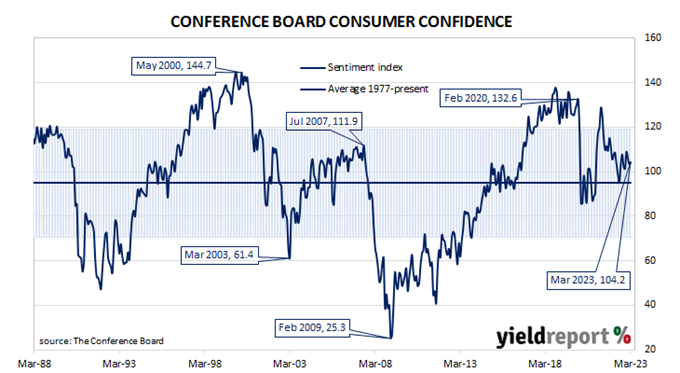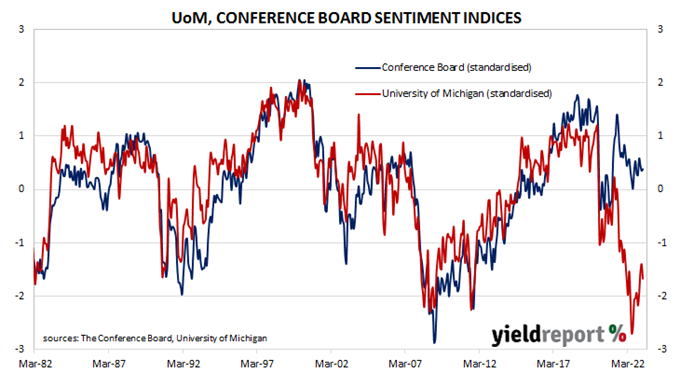Summary: Conference Board Consumer Confidence Index rises in March, reading more than expected; improved outlook for under 55s, households earning $50,000+; consumers taking little notice of recent bank failures; views of present conditions deteriorates, short-term outlook improves.
US consumer confidence clawed its way back to neutral over the five years after the GFC in 2008/2009 and then went from strength to strength until late 2018. Measures of consumer confidence then oscillated within a relatively narrow band at historically high levels until they plunged in early 2020. Subsequent readings then fluctuated around the long-term average until March 2021 when they returned to elevated levels. However, a noticeable gap has since emerged between the two most-widely followed surveys.
The latest Conference Board survey held during the first three weeks of March indicated US consumer confidence has improved. March’s Consumer Confidence Index registered 104.2 on a preliminary basis, higher than the expected figure of 101.5 and February’s final figure of 103.4.
“The gain reflects an improved outlook for consumers under 55 years of age and for households earning $50,000 and over,” said Ataman Ozyildirim, a senior director of economics at The Conference Board.
US Treasury yields generally moved higher. By the close of business, the 2-year Treasury bond yield had gained 5bps to 4.07%, the 10-year yield had added 2bps to 3.56% while the 30-year yield finished steady at 3.77%.
In terms of US Fed policy, expectations of a 25bps rise to the federal funds rate over the next 12 months firmed. At the close of business, contracts implied the effective federal funds rate would average 4.81% in April, 2bps lower than the current spot rate, and then climb to an average of 4.92% in May. June futures contracts implied a 4.905% average effective federal funds rate while April 2024 contracts implied 4.945%.
“It’s early days for the full impact of credit tightening to be evident for households, but Consumer Confidence suggested the consumer had taken little notice of recent bank failures,” said NAB economist Taylor Nugent.
Consumers’ views of present conditions deteriorated while their views of the near-future improved. The Present Situation Index declined from February’s revised figure of 153.0 to 151.1 while the Expectations Index rose from 70.4 to 73.0.
The Consumer Confidence Survey is one of two widely followed monthly US consumer sentiment surveys which produce sentiment indices. The Conference Board’s index is based on perceptions of current business and employment conditions, as well as respondents’ expectations of conditions six months in the future. The other survey, conducted by the University of Michigan, is similar and it is used to produce an Index of Consumer Sentiment. That survey differs in that it does not ask respondents explicitly about their views of the labour market and it also includes some longer-term questions.



